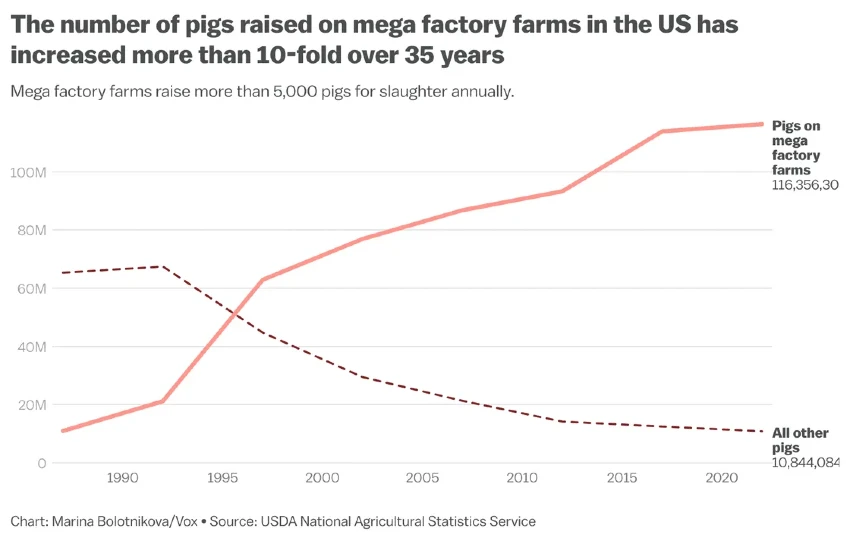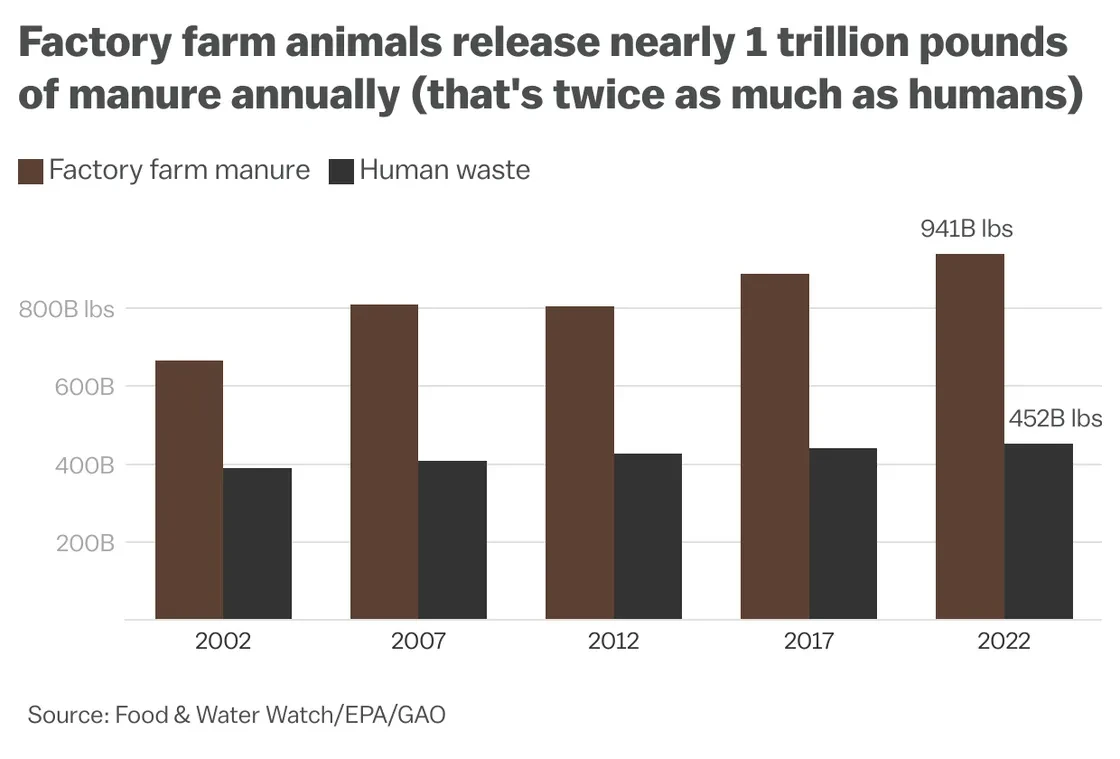Big Farms Keep Getting Bigger: The Hard Facts
Recent USDA data sheds light on a concerning trend: America’s largest farms are growing even larger, squeezing out the small farms and impacting our environment and health.
By the Numbers: A Decade of Change
In 2012, there were 2,109,303 farms with an average size of 434 acres. Fast-forward to 2022, and while the number of farms has decreased, the remaining ones have grown significantly in size, especially the largest categories. The growth isn’t just in acreage but also in the concentration of livestock, with cattle farms housing 5,000 or more head of cattle increasing by 29%, and chicken farms with over 500,000 birds up by 17%.

What You Should Know From The Reports
We sat down and compared the USDA’s 2012 report with the most recent for 2022 – a decade of valuable data-driven insights in those 1,400+ total pages. But don’t worry, there’s no need for you to waste your time pouring over those tables – we did it for you and here are the most important takeaways:
- Cattle Farms: From 1,124 in 2012 to 1,453 in 2022, a 29% increase in farms with 5,000 cattle or more.
- Chicken Farms: A 17% increase from 6,332 in 2012 to 7,406 in 2022 for farms with 500,000 or more birds.
- Hog Farms: From 3,006 in 2012 to 3,540 in 2022, with a peak in 2017 at 3,600.
- Cattle Production Increase: 28% more cattle in the largest facilities in 2022 than in 2012.
- Hog and Chicken Production Increase: Both saw a 24% increase in the number of animals produced in the largest farms.
- Broiler Chicken Production: Nearly 1.4 billion more chickens produced in 2022 than in 2012 in the largest farms.
- Broiler Chicken Farms Decrease: A 3% decrease, from 32,935 in 2012 to 31,877 in 2022.
- Cattle Farms Decrease: A 20% drop in the number of cattle farms, from 913,246 in 2012 to 732,123 in 2022.

Small Farms: The Vanishing Backbone
From 2012 to 2022, the shift away from small farms has been dramatic. The number of cattle farms fell by 20%, from over 913,000 to just over 732,000, yet the number of cattle produced increased by 29%!
Broiler chicken operations also saw a decline, albeit smaller, from nearly 33,000 to just under 32,000 while the output from the remaining large operators increased by 24%.
This trend towards fewer but larger farms has a profound effect on our communities, food, and environment. It means less variety in our food supply, more strain on the environment, and fewer families able to maintain the farming way of life. This decade-long trend underlines the urgent need for action to support the small farms that are such a crucial part of America’s agricultural fabric.
Environmental and Health Impacts: The Cost of Growth
The environmental toll is substantial. Larger farms mean more waste and greater methane emissions, contributing to pollution and climate change.
The manure problem is massive. These giant farms now churn out almost a trillion pounds of waste yearly—that’s double what all of us humans produce. With the sharp increase seen in 2022, managing this waste has become a critical issue. It’s not just about the sheer volume; it’s about where all that waste goes. It can end up in our rivers and streams, leading to pollution that affects both nature and our health.
The need for better waste management and stricter rules has never been clearer as these large farms continue to expand.

Market Values and Economic Classes: Who Really Benefits?
The market value of agricultural products has increasingly favored the larger operations, with small and medium-sized farms struggling to compete. The data from 2012 to 2022 highlights a growing economic disparity within the agricultural sector, emphasizing the need for policies that support a more equitable distribution of resources and opportunities.
More To Discover
- Panasonic’s Innovative Semi-Transparent Perovskite Solar Panels Look Like Windows or Walls
- Trees Are The Unexpected Climate Challengers on the Great Plains
- Bitcoin Miners Triumph in Court, Shielding Energy Secrets. Why It Matters.
- Australian Solar Farm Closure After 7 Years Sparks U.S. Debate on Renewable Energy’s Waste Challenge
A Call to Action: Steering Towards Sustainability
The USDA’s data from the last decade is a clear indicator that the path we’re on is unsustainable. It’s a call to action for policymakers, consumers, and farmers alike to support practices and policies that encourage sustainable farming, protect small farms, and mitigate environmental impacts.
Conclusion: The Future of Farming
The expansion of mega-farms represents a critical challenge to the sustainability of agriculture in the U.S. With the data from 2012 and 2022 in hand, the message is clear: without significant changes, the health of our planet and our food system remains at risk.




















